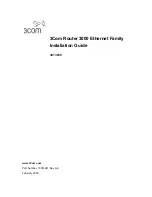
MIB Descriptions
C-8
7610-A2-GB20-10
November 1997
Interface Stack Group
The Interface Stack Group is used by the unit to show the relationship between a
logical interface and a physical interface. The following table provides clarification
for objects contained in the Interface Stack group when it is not clear how the
object definition in RFC 1573 is supported by the unit.
Table C-4.
Interface Stack Group Objects
Object
Description
Setting/Contents
ifStackHigher-
Layer
(ifStackEntry1)
Provides the index that
corresponds to the higher
sublevel specified by
ifStackLowerLayer.
When the In-band Management Channel
is enabled, this object for the DDS
network interface is set to the ifIndex of
the In-band Management Channel. All
other ifStackHigherLayer objects will
have a value of zero.
ifStackLower-
Layer
(ifStackEntry2)
Provides the index that
corresponds to the lower
sublevel specified by
ifStackHigherLayer.
When the In-band Management Channel
is enabled, this object for the In-band
Management Channel is set to the
ifIndex of the DDS network interface. All
other ifStackLowerLayer objects will
have a value of zero.
ifStackStatus
(ifStackEntry3)
Specifies the stack group’s
status compared to the
interface’s ifOperStatus.
Supported as a read-only
variable.
When ifStackStatus set to active –
maps to ifOperStatus set to up(1) or
testing(3).
When ifStackStatus set to not in
service – maps to ifOperStatus set to
down(2).
Interface Test Table
The unit uses the Interface Test table to provide access to additional tests such
as loopbacks and pattern tests, which are not included in the Interfaces Group of
MIB II.
Table C-5.
Interface Test Group Objects (1 of 2)
Object
Description
Setting/Contents
ifTestID
(ifTestEntry 1)
Provides a unique identifier
for the current request of
the interface’s test. Ensures
that the results of the test
are for that request. This
handles the rare condition
where another SNMP
Manager starts a test
immediately after
completion of a previous
test, but before the
previous test results are
received by the first SNMP
manager.
Set by an SNMP Manager before the
test is started. The unit then increments
the previous value. The value is then
checked after the test has completed.
















































